While being such a crucial part of daily life, the bathroom and the bathtub itself can be very intimidating to clean: The wet, nasty, and usually dreadfully bleachy process, the stubborn stains that won’t go away no matter how hard you scrub, the terror of black mold, the dreadful drain clog, and all the delicate […]

While being such a crucial part of daily life, the bathroom and the bathtub itself can be very intimidating to clean: The wet, nasty, and usually dreadfully bleachy process, the stubborn stains that won’t go away no matter how hard you scrub, the terror of black mold, the dreadful drain clog, and all the delicate and seemingly uncleanable fixtures. Our take, though, is that cleaning a bathtub only seems tricky because you haven’t got the know-how necessary to do it properly. We believe the simple, and yet thorough guide provided in this article is just the know-how you need to effectively deep clean your bathtub, clean up the most persistent stains and mold, and properly take care of tricky fixtures like the tub’s drain and jacuzzi jets.
The bathtub is essentially where you wash yourself to dump all the dead tissues, body hair, bacteria, and dirt accumulated on your body during a day of hard work and activities. And as dearly as we wish for them to go down the drain along with the water and soap, they simply won’t; they stay in the tub as soap scum and stains. To keep your tub in pristine condition, it’s crucial to remove stains effectively using safe and natural products, avoiding harsh chemicals that could damage the surface. That, together with how the smaller bathtub parts could be quite a hassle to clean, means your brand new, sparkling bathtub would turn scummy, greasy, and discolored quite fast; they need deep cleaning.
To deep clean a bathtub means that you (a) do more than just wipe off surface dust – you also clear the soap scum, stains, and bacteria that normally won’t go away with conventional dusting – and (b) clean all and every part of the bathtub, including fixtures like the drain, the jets, etc. All to restore your bathtub to its sparkling brand new state, making it a comforting, eye-pleasing delight when you return home from a hard-working day, visually, and hygienically.
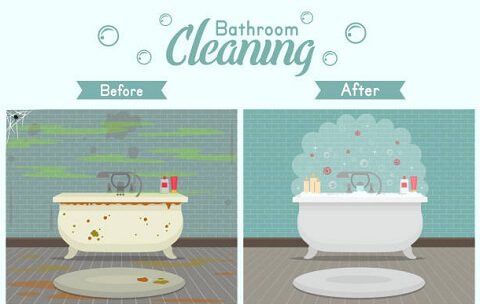
Deep cleaning, when done right, can restore your bathtub anew (Source: Internet)
The tips below from Sparkling & Beyond will help you deep clean your bathtub easier and more efficiently.
This section is dedicated to providing you with some general ideas on how to clean a bathtub entirely DIY.
You can easily deep clean a bathtub with products you can find at home. These include some common cleaning agents, some protective equipment to protect your skin, respiratory system, and eyes from these agents, and some cleaning tools. Here’s the list of things that you should prepare:
Protective equipment:
Household ingredients:
While commercial bathroom cleaners can make surfaces look pristine, they often contain harmful chemicals that can damage delicate materials like acrylic bathtubs. It’s safer to use natural cleaning alternatives.
Cleaning tools:
Before you start cleaning your acrylic tub, it’s essential to gather the necessary supplies and understand the materials you’ll be working with. Here’s a list of what you’ll need:
By preparing these supplies, you’ll be well-equipped to clean your acrylic tub effectively and safely.
Acrylic tubs are made from a type of plastic material that is both durable and lightweight. However, they require special care to maintain their appearance and longevity. Here are some key things to keep in mind:
Understanding these characteristics will help you take better care of your acrylic tub, ensuring it stays in great condition for years to come.
Step 1: Put on your protective gloves, safety glasses, and also the face mask/respirator in case you work with bleach.
Step 2: Spray the bathtub with a commercial cleaner or your own homemade concoctions (made from distilled vinegar, baking soda, dish soap, lemon juice, etc.). Let the solution sit for some time so the cleaner could chemically break down the soap scum and stains; tougher stains may take longer to break down, typically for half an hour.
As a note, different bathtub lining types (acrylic, enamel, or porcelain) may call for different types of cleaning agents, which we will discuss further in the next part of this article.
Step 3: Scrub the bathtub. Make sure to scrub from the top down so the debris would fall to the bottom of the tub and be cleaned off. Some bathtub linings are easier to scratch and thus require non-abrasive scrubbers.
Step 4: Take care of fixtures and crevices. Wipe the fixtures with a vinegar-wet cloth. For crevices, use a small, vinegar-dipped brush. For bathtub drains and jets, a detailed guide will be provided in later parts.
Step 5: Rinse the bathtub carefully. As a final touch, wipe the bathtub again with a dry cloth, so the bathtub would be free of moisture and bacteria won’t build up easily.
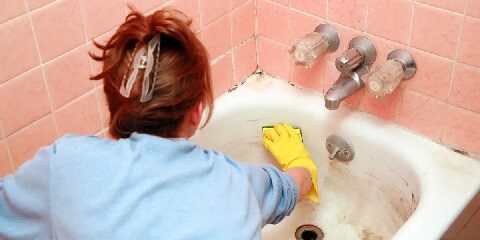
Cleaning tough stains on a bathtub (Source: Internet)
Stubborn stains require more potent cleaners and intense physical scrubbing to clean. However, some bathtub linings are particularly vulnerable to harsh cleaners and abrasion and will be damaged from the cleaning if the tools and cleaning agents are poorly chosen. Therefore, the cleaner and the cleaning tools must be selected accordingly with the lining material to clean bathtub stains effectively without damaging the lining. The most common bathtub linings include Acrylic, Enamel, and Porcelain. Additionally, removing stains using safe and natural products like vinegar and baking soda is crucial to prevent damage and maintain the bathtub’s appearance.
Acrylic bathtubs are notoriously vulnerable to abrasive chemical cleaners (like harsh astringent powders or bleach). Also, as a soft material, acrylic gets scratched very easily. However, it is perfectly safe to clean an acrylic bathtub with mild homemade concoctions like diluted vinegar (with a water-to-vinegar ratio of 2:1), as well as acrylic-safe commercial cleaners. And softer scrubbers like the yellow side of a dish sponge, interwoven cloth, or specialty sponge scrubbers like Mr. Clean Magic Eraser are the go-tos.
Enamel tubs are also particularly sensitive to abrasive and strongly-acidic cleaners. Such cleaners can cause the tub to develop nasty rust-like stains. So, for a homemade cleaner, baking soda may be the safer ingredient choice than vinegar. An enamel-safe commercial product is also an option. As for scrubbers, anything harsher than a sponge could wear down the enamel.
For a simple DIY baking soda cleaner paste, here’s a sample recipe: (1) 2 part baking soda, (2) 1 part hydrogen peroxide, mix to form a paste.
Unlike the other two materials, porcelain is much more scratch-proof and chemically resistant, making it much easier to clean. It is safe for abrasive cleaners including bleach; it also tolerates a range of sturdier scrubbers like the green side of a dish sponge, a pumice stone, or a stiff-bristled scrubbing brush. However, do not use steel wool or anything equally or more abrasive as they still can damage the porcelain.
For any of these bathtub type, the stain cleaning routine goes as follows:
As a tip, you can always check the label of a commercial cleaner to see if it’s safe for acrylic, enamel, or porcelain.
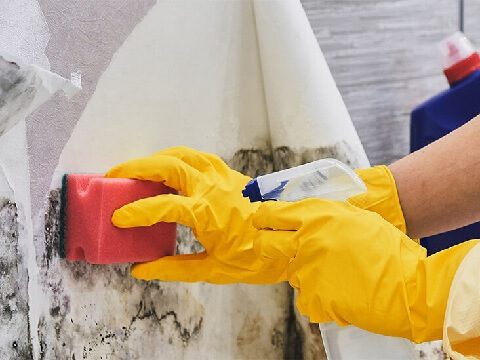
Black mold on bathtubs can be nasty to clean (Source: Internet)
Mold thrives in moist, oxygen-rich, and unlit environments like the bathroom and the bathtub itself. The good news is many mold killers excellent for cleaning bathtub mold are readily available in your cupboards, such as white vinegar or baking soda. While bleach is frequently quoted as an option, many problems have been reported concerning its effectiveness including risk of mold regrowth, and safety hazards. Thus, distilled white vinegar and baking soda stand out as both safer and healthier choices.
For baking soda, mix it with warm water at a 1:1 ratio to form a paste. For distilled white vinegar, the acidity is particularly mild (5% – 8%), so it’s safe for bathtubs without further dilution.
The cleaning routine goes as follows:
Step 1: Equip yourself with safety glasses, face masks, and goggles.
Step 2: Spread the baking soda paste/spray distilled white vinegar over the molded area, let it sit for at least one hour
Step 3: Scrub the area with a suitable scrubber (Refer to the previous section for the recommended scrubbers for your bathtub lining). For crevices, use a small scrubber brush.
Step 4: Leave to dry.
Notes:
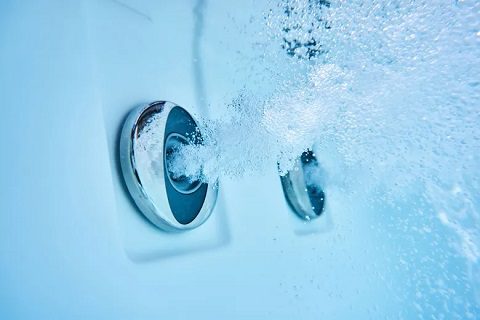
Cleaning bathtub jets can be quite difficult, but rewarding (Source: Internet)
Jacuzzi jets are truly a bliss to have in a bathtub. However, without proper cleaning, they can easily accumulate gunk, and spoil your bathwater; and they do appear quite tricky to clean. But no worries, with this simple guide, you will clean your bathtub jets much easier than you may expect:
Step 1: Fill the tub with hot water until the jets are 2-3 inches underwater.
Step 2: Add to the water 2 Tablespoons of a low suds liquid dish soap, and ½ cup of bleach in case of bad filth. For less urgent cleaning, substitute the bleach in the recipe with 1 cup of white vinegar for healthier, greener, and tub-friendly cleaning). Some manufacturers do not recommend bleach as well since it can dry out internal gaskets over time. You can also use powdered dish detergent in place of liquid ones.
Step 3: Run the tub’s jets for 15 minutes.
Step 4: Drain the tub, and refill it (cold water is fine this time). Run the jets for another 10 minutes.
Step 5: Drain the tub and rinse thoroughly to wash off the gunk
Step 6: In case you feel the jet needs intensive cleaning, work on it with a bottle brush and a nonabrasive cloth.
Step 7: If dirt is still visible around the jet covers, you can clean them by using dental floss to reach their backside.
Note: Before taking up this routine, make sure to check with the jet’s user manual. Some manufacturers recommend closing the air controls during cleaning, while others recommend having them stay open. Some manufacturers also recommend specific cleansers for their tubs.
A clogged bathtub drain causes the tub to drain slower, leaving behind watermarks, soap scum, stains, bacteria, and mold problems as well. So you need to clean your bathtub drain, and these simple steps will help you do the job properly with relative ease.
Step 1: Put on protective gloves. Use a straightened wire hanger with one end bent into a small hook to pull out hair and any other debris that’s blocking the drain.
Step 2: Pour hot water down the drain. Then pour in a solution of 1 cup of baking soda and 1 cup of vinegar. Wait for 15 minutes then flush the drain with hot water.
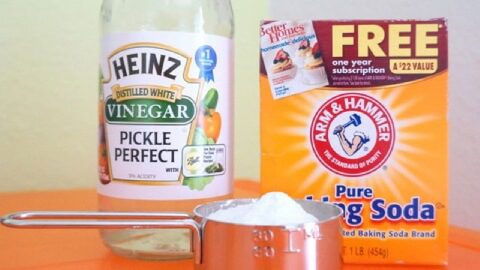
Vinegar and baking soda make up great homemade cleansers (Source: Internet)
If you’re looking for alternative cleaning solutions for your acrylic tub, here are some options you can try:
These alternative solutions are not only effective but also safe for your acrylic tub, helping you keep it clean without causing damage.
Here are some common issues you may encounter when cleaning your acrylic tub, along with some troubleshooting tips:
By addressing these common issues with the right techniques and products, you can keep your acrylic tub looking its best.
Here are some best practices to keep in mind when cleaning your acrylic tub:
By following these best practices, you can maintain your acrylic tub’s appearance and functionality, ensuring it remains a beautiful and relaxing part of your bathroom.
These are some amazing and simple cleaning routines that allow you to clean the bathtub properly, using only products that can easily be found at home. Nonetheless, if you feel that professional help is needed, contact us at Sparkling & Beyond cleaning services. We provide professional and affordable bathroom cleaning, as well as a wide range of cleaning services for any part of the house, for any degree of need. We’ll keep your home sparkling clean and healthy. Also, stay tuned for more do-it-yourself cleaning tips and guides from us.
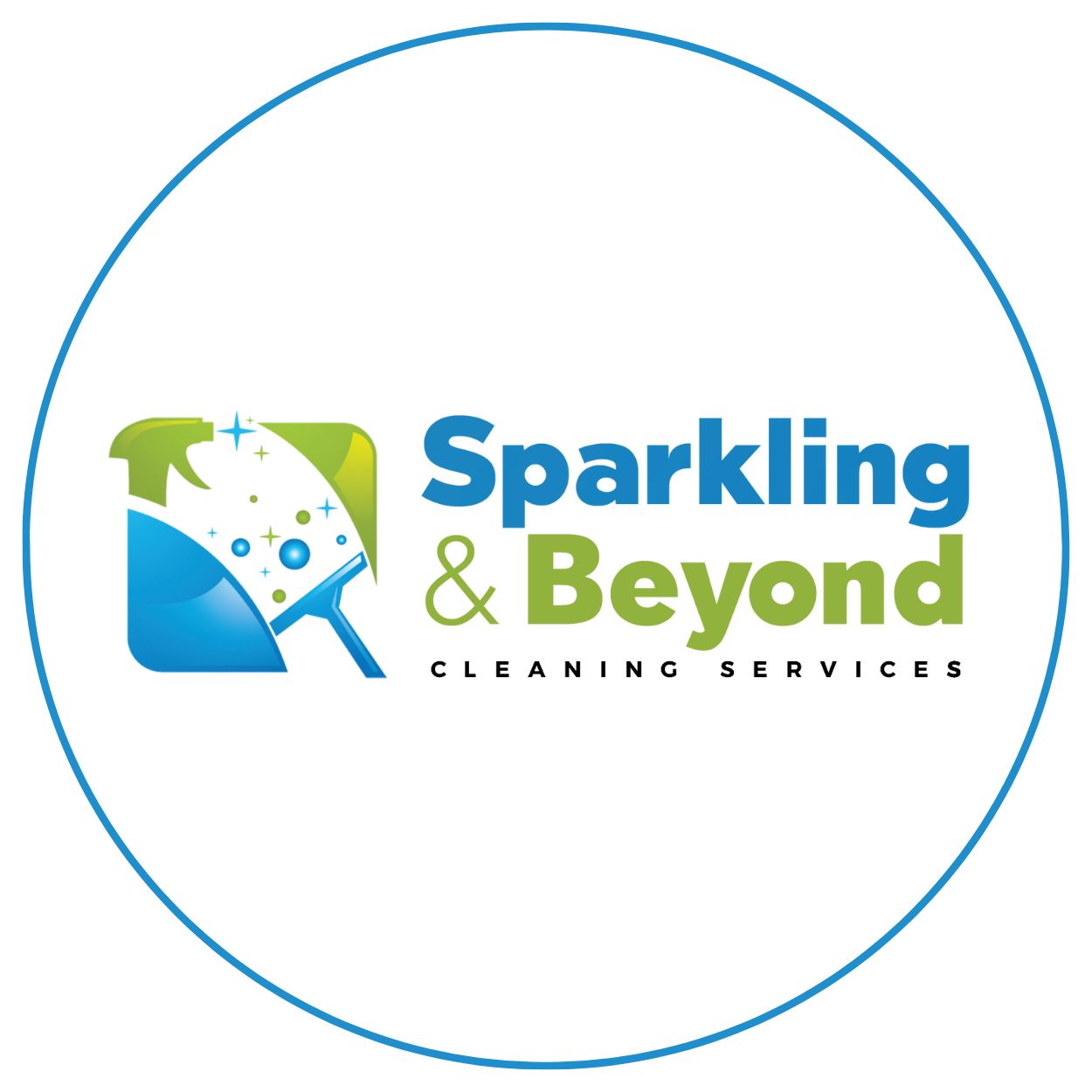
As the admin of Sparkling & Beyond, I bring a wealth of knowledge and passion for excellence in the cleaning industry. With years of experience in providing top-notch cleaning solutions, I am dedicated to sharing valuable insights and tips to help maintain pristine and healthy living environments. My mission is to ensure every home and office we service sparkles with cleanliness and comfort.
![]()